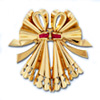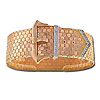- sale
- new items
- lovely beads
- wedding beads
- beads for teens
- for custom order
- newsletter
- recognition
- testimonials
- birthstones
- zodiac signs
- jewelry guide
SHOP BAG
![]() in your bag 0 items
in your bag 0 items
We know that everything new is well-forgotten old; and we often get inspired by the images from past and apply to them the term "retro". Wikipedia article states, "Retro is a culturally outdated or aged style, trend, mode, or fashion, from the overall post-modern past, that has since that time become functionally or superficially the norm once again. The use of 'retro' style iconography and imagery interjected into post-modern art, advertising, mass media, etc. It generally implies a vintage of at least 15 or 20 years. For example clothing from the 1980s or 1990s could be retro." In general, "retro" actually means "pretty old".
Reading articles on jewelry by historians, we can learn something new: it turns out there is a definite jewelry style named "retro jewelry" applied to items created between approximately 1935 and 1945 (although actually up to 1950)! The name "retro" was given to this jewelry style by Francois Curiel, the head of the jewelry department for Christie's Auction House in New York in the early 1970's.
Retro jewelry, or "Cocktail Jewelry" as it is sometimes called, originated in France with designs by Van Cleef & Arpels. They produced a collection of jewelry that was exhibited at the 1939 World's Fair in New York. When World War II broke out, the jewelry remained in New York, serving as a great influence to American jewelry designers throughout the remainder of the war.
Retro jewelry was common in Hollywood movies and is very colorful, bold, elaborate and oversized with three dimensional use of rose, yellow and green, highly polished gold. Commonly worn pieces reflected the glamour and enchantment that Hollywood inspired during times of crisis and were large cocktail rings, bracelets, watches, necklaces, chunky and charm bracelets, big clips and brooches. There was still much uncertainty about paper money and in times of economic skepticism precious metal and gems represent portable capital.
Huge deposits of gems were discovered in Brazil in the 30's as the result of geological excavations searching for industrial minerals to fuel the war, hundreds of localities became known for Brazilian deposits of gems. The most popular gemstones seen in retro jewelry are aquamarine, citrine, topaz, large cabochon-cut rubies and sapphires, golden beryl, peridot and tourmaline. Most of these gems were exceptionally large.
Birds, baskets of flowers, dancers and other serene images were common motifs. Ballerinas, bows, animals, shells and hearts were also recurrent designs in jewels of the period, often accented with sprays of diamonds and twists and spirals of calibre-cut precious gems. The ribbon bow was the most popular motif, often highlighted in the center with a cut ruby or sapphire knot. Retro jewels imitate three dimensional folds of fabric, easily separating them from the two dimensional Art Deco clips or Victorian bows.
The French jeweler Mauboussin had said, "The jewellery of the Forties was the jewellery of an age of crisis, so it is only logical that it should come to an end with the crisis itself." (M. Gabardi, The Jewels of 1940 in Europe, 1982)
Information used in this article is courtesy of The Antique Jewelry University



